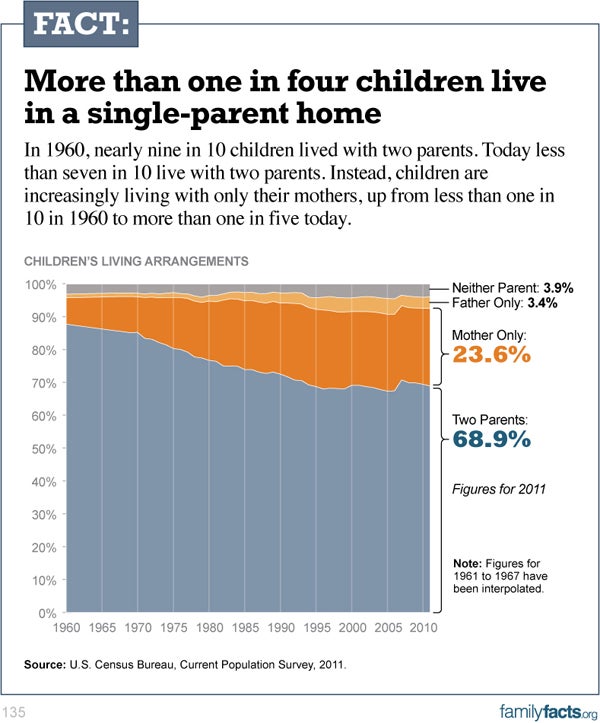Family Fact of the Week: The Dad Divide in Children’s Welfare
Christine Kim /
A recent New York Times article about the growing marriage and class divide in America featured two middle-class families in Ann Arbor, Michigan. At the heart of the story are the disparate lives of their children. Jeremy, 12, and his brother, Justin, 10, are raised by married, college-educated parents. Kirsten, 11, Steavon, 10, and Savannah, 7, are raised by their single mom, who had dropped out of college.
Both are loving and hard-working families, but “what most separates them is not the impact of globalization on their wages but a 6-foot-8-inch man named Kevin,” Jeremy and Justin’s father. By contrast, the absence of Kirsten, Steavon, and Savannah’s father is acutely felt. Directly and indirectly, it affects them and their mom financially, educationally, socially, emotionally, psychologically, and behaviorally.
According to the Census Bureau, more than one in four children lives with single parents (primarily single moms). Since 1960, the percentage of children in single-parent homes has more than doubled. In the 1970s and 1980s, divorce was the primary contributor to the growing share of children in single-parent families. In recent decades, the explosion in unwed childbearing has been the main driver. Today, more than one-quarter of children born are to unmarried mothers.
(Continued below charts)
For decades, family breakdown has been associated with the more disadvantaged, the less educated. Yet divorce, unwed childbearing, and cohabitation are happening increasingly among the moderately educated—those with a high school degree and perhaps even some college—widening the class divide as Middle America retreats from marriage and the educated become more marriage-minded and stably married. Like the married family featured in the Times article, the latter finish their college degrees, establish careers, get and remain married, and then have children.
The transformational change in America’s family structure is contributing to the growing gap in Americans’ economic and family life. Researchers estimate that “[c]hanges in family structure may explain anywhere from 15 to 40 percent of the increased inequality in recent decades.” They may also impede the economic mobility of the next generation, even for the wealthy.
Moreover, Heritage Foundation research has documented that unwed childbearing is a major cause of child poverty. Single-parent families are six times more likely to be poor than married families. Marriage, then, is the number one weapon against poverty. It drops the likelihood of child poverty by more than 80 percent.
But the consequences of family breakdown are much more than just monetary. Many children of single parents grow up to be successful individuals, but Brad Wilcox, a University of Virginia sociologist and director of the National Marriage Project, points out that “the academic research paints a much more complicated picture of the impact of family structure on children.”
As examples, he cites research of Princeton professor Sara McLanahan finding that “boys raised in a single-parent household were more than twice as likely to be incarcerated, compared with boys raised in an intact, married home, even after controlling for differences in parental income, education, race, and ethnicity.” Findings from other studies suggest that boys “are less likely to engage in delinquent or illegal behavior when they have the affection, attention, and monitoring of their own mother and father.” (Emphasis added.)
A study by University of Arizona professor Bruce Ellis “found that about one-third of girls whose fathers left home before they turned 6 ended up pregnant as teenagers, compared with just 5 percent of girls whose fathers were there throughout their childhood.” Accounting for parental socioeconomic background narrowed the gap by only a few percentage points. Diminished parental supervision and early onset of sexual activity partially explain the gap.
Decades of social science research shows the importance of having a married mom and dad from the beginning for children’s flourishing. And the experiences of Jeremy, Justin, Kirsten, Steavon, and Savannah remind us that behind the data are real families and real children.



